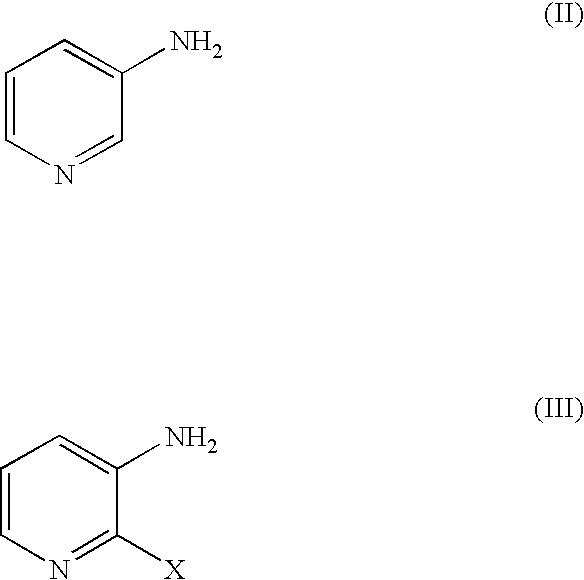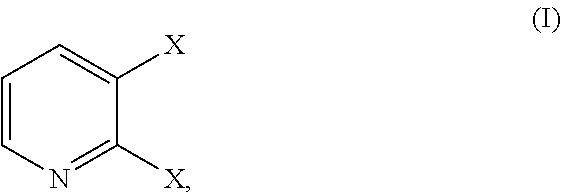Process for producing dihalopyridines
a technology of dihalopyridine and process, applied in the direction of organic chemistry, etc., can solve the problems of dihalopyridine produced by the process disclosed, not disclosed, and difficult to achieve the purification process
- Summary
- Abstract
- Description
- Claims
- Application Information
AI Technical Summary
Benefits of technology
Problems solved by technology
Method used
Image
Examples
example 1
[0066]One Pot Process for the Preparation of 2,3-dichloropyridine
[0067]Sodium hypochlorite (1120 g, 1.8 mol) was added to a mixture of nicotinamide (200 g, 1.64 mol) and DM water (700 g) in a RB flask under stirring at about 0° C. over 60 minutes. To this mixture aqueous sodium hydroxide (260 g, 3.0 mol) was added and the solution was heated and stirred at 90° C. for 2 hrs. Concentrated hydrochloric acid (468 g, 4.23 mol) was then added and the mixture was concentrated to obtain crude 3-aminopyridine solution. To this crude 3-aminopyridine solution, concentrated hydrochloric acid (1200 g, 10.85 mol) was added again at 0° C., followed with ferric chloride (5.5 g, 0.034 mol). The chlorine gas was then spurged (125 g, 1.78 mol) at room temperature. The resulting solution was cooled to about −8° C. and a solution of sodium nitrite (105 g, 1.52 mol) in water (140 ml) was added over 2-3 hrs. The resulting mixture was charged to a mixture containing cuprous chloride (109 g, 1.1 mol) and co...
example 2
Preparation of 3-amino-2-chloropyridine
[0069]3-Aminopyridine (25 g, 0.265 mols) was added to DM water (50 g) in a RB flask under stirring at 25-30° C. To this mixture concentrated aqueous hydrochloric acid (207 g, 1.7 mols) and ferric chloride (1.0 g, 0.006 mols) were added. Chlorine gas was then sparged into the reaction mass. The completion of the reaction was monitored by HPLC. After the completion of reaction, the pH of the crude mass was adjusted to 9-11 with sodium hydroxide solution and filtered. The crude mass was than dissolved in toluene at 65-75° C., filtered and concentrated to give 25.63 g of 3-amino-2-chloro-pyridine (75% yield) which contain about 2-3% of 3-amino-2,6-dichloropyridine by %area HPLC. Melting point: 76° C. to 78° C.; HPLC purity 96.4%. The toluene was kept aside for recycling. The product was confirmed by mass spectroscopy and 1H NMR.
[0070]ms:m / e 129(M+); 1H NMR (DMSO-D6) δ 7.12-7.07 ppm (m, 4H; 6H, 2H), δ 7.56 ppm (dd, 5H, 1H), δ 5.56 ppm (s, br, 3H, NH...
example 3
Preparation of 2,3-dichloropyridine
[0071]To the flask was charged 3-amino-2-chloro-pyridine (25 g, 0.194 mol), obtained in Example 2, and aqueous hydrochloric acid (235 g, 1.9 mol). After the mixture was cooled to −8 to −3° C., a solution of sodium nitrite (16.15 g, 0.234 mol) in water (24 g) was added over 2-3 hours. This diazonium chloride salt mixture was transferred to an addition funnel and added to the flask containing aqueous hydrochloric acid (95 g, 0.78 mol) and cuprous chloride (27 g, 0.272 mol) at 60-70° C. The completion of the reaction was monitored by HPLC. After the completion of reaction, the toluene was charged in reaction mass and undesired products were extracted in organic phase and discarded. The separated aqueous mass was diluted with DM water, extracted with toluene. Toluene is concentrated to dryness to obtain 21.44 g of 2,3-dichloropyridine (75% yield); Melting point 64° C. to 67° C.; HPLC purity 98.6%. The toluene was kept aside for recycling. The product w...
PUM
| Property | Measurement | Unit |
|---|---|---|
| temperature | aaaaa | aaaaa |
| pH | aaaaa | aaaaa |
| pH | aaaaa | aaaaa |
Abstract
Description
Claims
Application Information
 Login to View More
Login to View More - R&D
- Intellectual Property
- Life Sciences
- Materials
- Tech Scout
- Unparalleled Data Quality
- Higher Quality Content
- 60% Fewer Hallucinations
Browse by: Latest US Patents, China's latest patents, Technical Efficacy Thesaurus, Application Domain, Technology Topic, Popular Technical Reports.
© 2025 PatSnap. All rights reserved.Legal|Privacy policy|Modern Slavery Act Transparency Statement|Sitemap|About US| Contact US: help@patsnap.com



